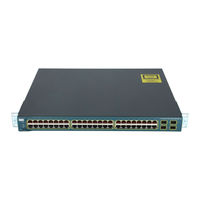Cisco WS-C3560G-24PS-E Manuals
Manuals and User Guides for Cisco WS-C3560G-24PS-E. We have 1 Cisco WS-C3560G-24PS-E manual available for free PDF download: Software Configuration Manual
Cisco WS-C3560G-24PS-E Software Configuration Manual (892 pages)
Software Configuration Guide
Table of Contents
-
Features39
-
-
-
-
-
-
CMS Icons80
-
-
-
-
IP Addresses111
-
Host Names111
-
Passwords112
-
LRE Profiles113
-
-
Configuring NTP126
-
-
-
-
-
-
RADIUS Operation173
-
-
-
-
Device Roles198
-
-
-
-
-
-
-
Token Ring Vlans249
-
Deleting a VLAN254
-
-
Displaying Vlans260
-
-
Configuring VMPS271
-
-
-
The VTP Domain280
-
VTP Modes281
-
VTP Version 2282
-
VTP Pruning282
-
-
Configuring VTP282
-
-
Domain Names286
-
Passwords286
-
VTP Version287
-
-
Monitoring VTP293
-
-
-
Configuring STP302
-
-
STP Overview302
-
-
Blocking State306
-
Listening State306
-
Learning State306
-
Forwarding State306
-
Disabled State307
-
-
-
-
-
-
-
-
Configuring MVR383
-
-
-
Configuring UDLD420
-
-
-
Local SPAN426
-
Remote SPAN426
-
-
SPAN Sessions427
-
Source Ports429
-
Source Vlans430
-
VLAN Filtering430
-
Destination Port431
-
Rspan Vlan432
-
-
-
-
-
-
-
Configuring SNMP472
-
SNMP Examples481
-
-
-
Supported Acls484
-
Port Acls485
-
Router Acls486
-
VLAN Maps486
-
-
-
-
-
Numbered Acls505
-
Extended Acls505
-
Named Acls506
-
ACL Logging507
-
-
-
-
-
Basic Qos Model525
-
Classification526
-
Mapping Tables532
-
-
-
-
-
-
-
Types of Routing610
-
-
-
Configuring RIP627
-
Configuring IGRP631
-
Configuring OSPF636
-
Configuring BGP651
-
-
-
-
Configuring HSRP689
-
-
-
-
IGMP Version 1699
-
-
-
IGMP Version 2699
-
PIM Versions700
-
PIM Modes700
-
Auto-RP701
-
Bootstrap Router701
-
-
-
-
-
-
-
-
-
MSDP Operation750
-
MSDP Benefits751
-
-
Configuring MSDP752
-
-
-
-
Using Ping791
-
Executing Ping791
-
Appendix
801 -
Supported Mibs
801-
MIB List801
-
-
Appendix
805 -
-
-
Copying Files808
-
Deleting Files809
-
-
-
-
Appendix
839 -
-
ARP Commands840
-
Hsrp
842 -
Msdp
847 -
Radius
848 -
Snmp
848 -
Vlan
848 -
Vtp
849 -
I N D E X
851
Advertisement
